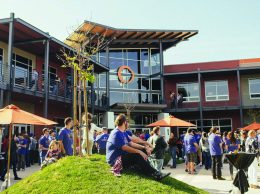Dooling: Think before adding technology to classroom

Todd Dooling
By Todd Dooling
Technology is entwined throughout our society. It is part of daily lives, our work and our fun, and everyone is using it to assist in learning. Every industry is embracing these disruptive technologies in their search for efficiency or, better yet, competitive advantage.
When it comes to our schools, though, success requires that we thoughtfully determine the right way to integrate technology into the learning experience of our children.
Ask yourself this question: Should your kindergartener be introduced to technology? What about your first-grader or second-grader? When is the right time to make use of technology in the classroom and in what classes should it be used?
I am an advocate of integrating technology into the classroom as I believe that, in the right situation, student learning can be enhanced and instructional and administrative functions could be made more efficient. High school students clearly should be leveraging technology tools in their classes, and one could certainly argue this applies to middle school. But I struggle when considering elementary school. It is in these grades that children are learning their social skills and really experiencing the world through their senses.
Those who embrace bringing iPads in the classroom beginning with kindergarten espouse that children must be taught skills that will carry them forward in adulthood. But children are entering school heavily tech savvy. Studies indicate that children are already spending a significant percentage of their hours each day using these tools. Children as young as 2 have access to tablets and smart phones, and the time spent on these devices is displacing important social interactions, physical activity and outdoor time.
I think schools that have made the determination to keep technologies like these out of the classroom in the early years are on the right track. One such school is Waldorf School of the Peninsula. Waldorf prefers to allow students to interact with one another and their teachers. The administrators believe that “by exploring the world of ideas, participating in the arts, music, movement and practical activities, children develop healthy, robust bodies, balanced and well-integrated brains, confidence in their real-world practical skills and strong executive-function capabilities.”
Once we determine the timing for the introduction of technology into the classroom, we need to consider how this should take place. I participated in a Parent-Teacher Organization meeting several years ago where parents debated whether to use proceeds from a fundraising event to buy computers for all the classrooms or fund the afterschool physical education program. There were passionate pleas from both sides. I took issue with the fact that there wasn’t a clear plan for how the computers would be integrated into the curriculum. I suggested that since we had much more clarity about the PE program plans that the investment should be made there. I further proposed that we take the next year to work with educators and administrators to decide how our program would look once it was enabled with an investment in technology. My suggestion was met with not only disagreement but anger.
There is a valuable truth that I have seen repeatedly during my career: Simply buying a tool does not ensure it will be used properly. Successful use of tools requires a vision of the end state you are trying to achieve. It requires a thoughtful review and potential re-engineering of current processes to leverage the new capabilities of the tool. Without these important precursors, the investment in the tool is simply that, and no benefit is realized for the organization.
I want to reiterate that I am a staunch proponent of leveraging technology in our schools. We simply need to have a vision and a plan to achieve that vision beyond the purchase of the technology. In the end, we all want our children empowered by their experiences in our schools.
• Todd Dooling is a senior adjunct faculty member in the California Lutheran University School of Management.











